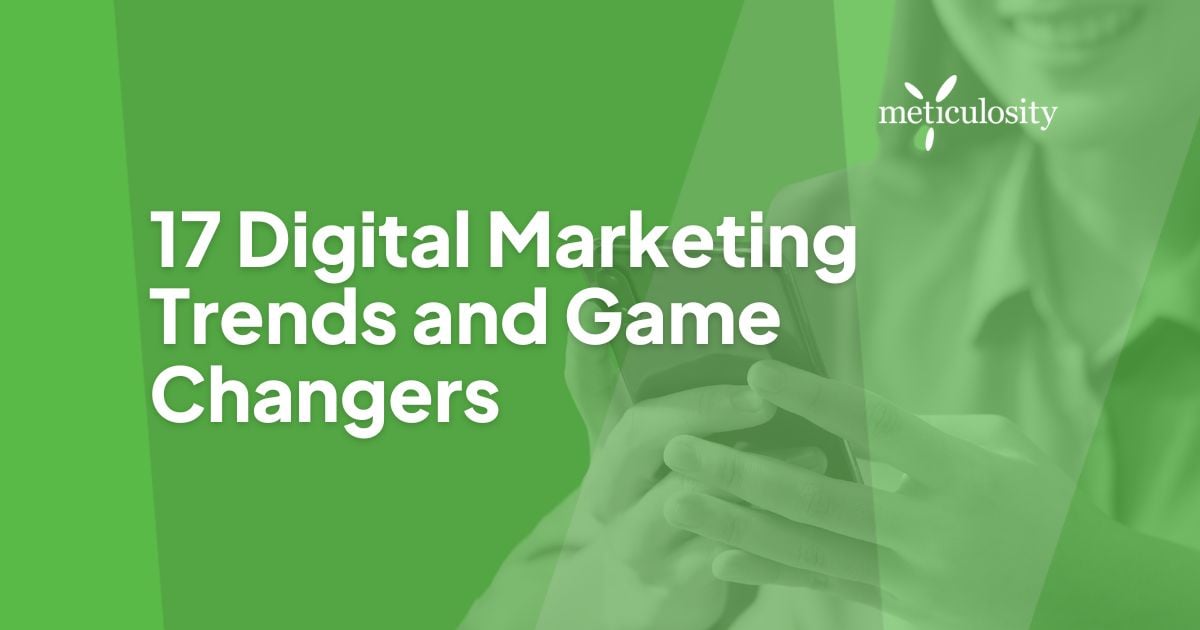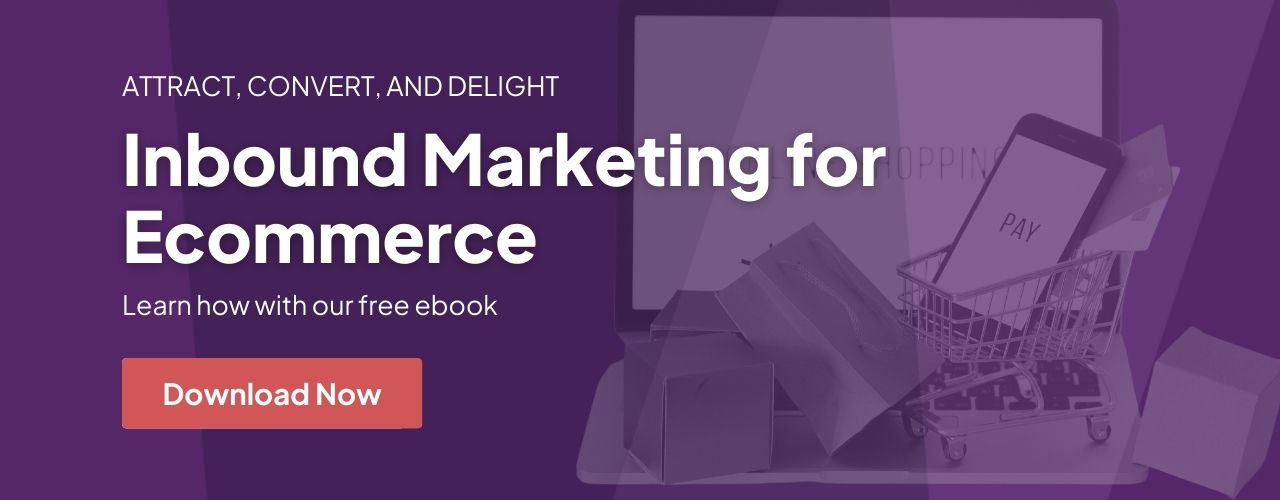It’s no secret that a solid digital marketing strategy has earned its rightful place as a lead generating, prospect converting and revenue boosting weapon for modern marketers. Every year digital marketing continues to evolve with new tactics.
With the proliferation of online marketing and the noise consumers have to fight through to get to the right products, it is more important than ever to be relevant and earn the trust of your audience.
With all the digital marketing trends and resources available to marketers, how do you know which ones should get your time and attention?
FREE GUIDE - Grow your Business Better with Digital Marketing. Grab your Copy Now.
Top Digital Marketing Trends
Here are 17 digital marketing trends that are changing the game for digital marketers.
1. Digging into the Buyer Journey
Digital marketing is all about collecting data, but how are you using that data? Consumers have more choices than ever before, and smart marketers look for every opportunity to differentiate the customer experience. Customers have never been more empowered to demand exceptional experiences. They expect to be treated as individuals and for businesses to understand their problems and proactively offer a solution to them with very little effort on their part.
Digital data collection affords marketers the opportunity to collect data at every stage of the buyer's journey to better understand it and to improve customer experience. Take what you know and create a customer journey map. Not only will you better understand customer expectations, you’ll be able to more accurately predict future buying behaviors.
2. Video Marketing
It’s becoming the norm for marketers to use video in their promotional efforts. Embedding a video in an email can create a remarkable increase in the click-through rate. Using video provides users with another level of clarity, and it also adds a human touch to your message.
Best of all, shooting video isn’t as expensive as you’d think – in many cases, you can create high-quality content using a smartphone. You can add conversion points to your videos, like asking the user to enter his or her email to continue watching. Use analytics to determine where viewers are located and where they drop off.
It’s best to keep your initial videos concise and focused on one idea. How-to videos are popular choices, as they’re highly shareable across social media platforms. Develop a straightforward script that speaks directly to your target audience and helps them solve a specific problem.
Video is one of the fastest growing marketing channels today. Done right, video is an effective, memorable way to boost brand impressions. The old adage that a picture is worth a thousand words still rings true today. Consider using video for product how-to’s, your FAQ and even short product review videos. Center your video content around your story—not around selling. Don’t be afraid to have a sense of humor, either. The videos that go viral aren’t dry, boring marketing content. Get your creative juices flowing.
- TIP #1: don’t forget to link back to your website in your video to drive traffic and generate leads.
- TIP #2: video is an inexpensive and engaging way to convert visitors.
3. A Focus on the Right Influencers
As online video content continues to infiltrate digital platforms, companies are inspecting how they work with influencers. Instead of casting a wide net, fish for influencers that truly align with your brand and your audience. Otherwise, you risk coming across as disingenuous and unconcerned with solving problems for consumers who are actually interested in your products and services.
As a bonus, targeted influencer marketing is a great vehicle for cross-promotion. By engaging with brands who complement yours, you’ll gain exposure to their audience and naturally broaden your reach.
4. Augmented Reality as a Marketing Tool
Augmented reality (AR) isn’t just for video games anymore. Virtual reality and augmented reality are quickly changing the ways brands interact with their consumers.
Many organizations are using AR with their social media platforms to engage with consumers. Retailers are using it for virtual fitting rooms. Home improvement companies use AR for interior design planning. Find the angle that fits your brand and use it. Besides making people talk about your business, it gives you one more opportunity to collect data and get your message in front of a broader audience.
/Imported_Blog_Media/virtual-reality-3d-goggles-PXS2TAH-550x367-3.jpg?width=550&name=virtual-reality-3d-goggles-PXS2TAH-550x367-3.jpg)
5. Targeted Ads
We’ve all heard that humans have a shorter attention span on average, than a goldfish. For this reason, your ads need to appeal directly to your target buyer. It requires some research on the front end about who you’re marketing to and where they get their information, but it’s worth it.
Unlike commercial advertising, that puts the same message in front of every single television viewer tuned in to that channel, digital advertisers have the advantage of catering to a specific audience. Don’t waste time on platforms or messaged your audience doesn’t care about. You’ll never reach them. Use demographics, and your visitors’ browsing history to customize the user experience on your website. With branding trends audiences expect an experience that feels custom-made for them.
6. Live Streaming
Live streaming is a new flavor of video marketing that has exploded in recent years with the proliferation of platforms like Facebook Live, Instagram Stories and others.
Instead of recording a video, live streaming allows you to engage with your audience in real-time. By doing so, you “ditch the script” and show yourself as a relatable, human brand, and connected to your audience.
It’s also a good way to create excitement around an event and to quickly gather sentiment data from your audience to see what kind of impression you’re making. This is definitely one trend to keep on eye on in the world on digital marketing.
7. Conversational Chatbots
If you’re unable to support 24/7 support, chatbots are a great way to extend customer service hours and provide a better experience for your customers. Chatbots are more intelligent and intuitive than ever before, and an efficient way to address common customer support questions. They are easy to set up, easy to program, and most importantly, easy to change on the fly.
While many considered chatbots trendy when introduced a few years ago, more organizations than ever rely on chatbots to differentiate their customer experience and offer continuous support to their customers.
8. A Personalized Experience
How your company reaches out to leads, customers, and website visitors shapes the way your brand is perceived. When trying different types of marketing emails, incorporate personalized subject lines to evoke a sense of familiarity with the reader.
It’s important to personalize the email content so that the users’ experiences are tailored to their needs and behaviors. One way to do this is to segment your contacts based on life-cycle stage, browsing activity, or demographics.
Run A/B Testing
To find out which personalization strategies are working, you can perform an A/B test. You can run tests based on what you believe your users’ motivations are, such as CTA buttons or conversion point placement.
Stop Mass Producing
Mass email blasts and one-size-fits-all landing pages no longer cut it. In the hyper-competitive digital world, consumers have plenty of choices. They gravitate to the brands that differentiate themselves from the masses.
Solve User Problems
Understanding your target audience and writing your email and web content to solve their problems will make you stand out.
While it’s impossible to deliver one-of-a-kind messages to every consumer, you can deliver a unique experience to subsets of your consumer population if you understand buyer personas. It will pay off in the form of brand loyalty, more referrals and a higher lifetime customer value.
/Imported_Blog_Media/a-person-using-a-mobile-phone-and-laptop-P3LKN2C-550x367-1.jpg?width=550&name=a-person-using-a-mobile-phone-and-laptop-P3LKN2C-550x367-1.jpg)
9. Contextual Behavior Tracking
Contextual marketing or behavior tracking takes the data that consumers provide online and uses it to drive future behaviors, such as making a purchase or downloading a piece of content.
As General Data Protection Regulation (GDPR) measures become more stringent for websites, marketers need to find new ways to track user behaviors and still remain in compliance. Contextual behavior tracking automates which ads and content consumers see, based on previous behaviors and browsing information. By using an automated system, marketers can stay compliant but still drive viewer behavior to create more conversions with digital marketing efforts.
10. Native Content
Know where your audience is reading your content and make sure your advertising and content is in the right context. Integrated content boosts engagement and makes it far more likely that your message will get shared.
Don’t take the short-sighted approach of marketing for one demographic and one platform in digital marketing. Native advertising should be so unobtrusive and natural it feels like it belongs in your audience’s content stream.
For example, have you ever read a “sponsored ad” while you were scrolling through your news feed? The best ones don’t require you to think before you look at them—they are contextually relevant and easily draw in readers. Before you know it, you’ve clicked on the sponsored content and engaged with the brand. Aim to be that ubiquitous in your audience’s newsfeeds.
11. Track Cost-per-experiment
There is a never-ending menu of channels and tactics and metrics available in the world of digital marketing. Instead of banking on one set of tools, smart marketers experiment, test, and adjust.
Decide what metrics are most important to your success and then pick a few tactics or channels to support them. If they don’t perform well, pick some different tactics that deliver a more desirable result. It isn’t failure to admit that a strategy isn’t working the way you’d hoped. It's a mistake, however, forge ahead with something that isn’t working, when instead you could reap positive results with something else.
An easy way to give your strategy an edge is to incorporate some A/B testing on the front end of each new tactic to see what content variations perform best. In digital marketing it's about having the freedom to adjust your campaign to find success.
12. Use Analytics to Your Advantage
Analytics are an essential part of any digital marketing campaign. Metrics determine where you focus your efforts next. Analytics also mean much more for today’s digital marketer than watching your web traffic or search rankings.
APIs and integrations have opened the door for businesses of all sizes to better predict which tactics will work for them. The data extends beyond just web performance and you can slice it a myriad of ways. For example, how is your social media strategy performing?
Crosshatch that data with your PPC ad spend. Are you spending the right money on the right platform? With a smorgasbord of analytics applications and web tools—some that integrate with a simple click of the mouse, marketers can test their hypotheses and measure success at every stage of the buyer journey. This is especially helpful if you have to fight for your budget dollars. With analytics, you have the data to support your budget request.
13. Use Voice Search
As Alexa, Siri and Google Home gain popularity, smart marketers look for ways to gather data and insert their brand influence into voice platforms. Understand what searches are looking for and how they ask for it will help you optimize your content and found in voice searches. A few quick tips:
/Imported_Blog_Media/woman-working-with-reports-and-charts-PDREVWQ-550x367-4.jpg?width=550&name=woman-working-with-reports-and-charts-PDREVWQ-550x367-4.jpg)
- Don’t overlook opportunities for sponsorship to reach the millions of consumers who use voice search technology.
- Try long-tail keywords that are more conversational in nature and that match how a voice-searcher may ask questions. For example, try a keyword string like “What is the best shoe for hiking?” instead of “hiking shoes.”
14. Machine Learning
Machine learning has gained popularity over the last few years as a smart way to strategize and automate marketing efforts. Marketers can collect all the data in the world, but if they don’t use it to their advantage, it’s all worthless.
By analyzing performance metrics through both historical and real-time reports, machine learning algorithms course-correct marketing strategies. Digital marketers are using machine learning to optimize SEO, PPC campaigns and even refine content marketing strategies. Eventually, machine learning may impact the way we tell stories as algorithms make recommendations on how we reach our audiences.
15. Content Marketing 3.0
With content trends of the rise this year, experts have their opinions on content marketing. One thing is for certain, content marketing should be the foundation of your digital marketing strategy. It is no longer just about creating a library of long-form content, however.
As discussed above, consumer attention spans are decreasing, and the way buyers want to see information is constantly evolving. Present digital content in small, consumable bites and on a variety of platforms. Use it as a multiplier to place the same message in different platforms, the way consumers want to read it.
16. Aligning Sales & Marketing
Marketing and sales typically have the same goal in mind - ROI and more revenue for the company. When the two departments collaborate, it results in a shorter sales cycle and increased efficiency.
Recent studies have shown that companies that have successfully synched their sales and marketing teams generated 208 percent more revenue from their marketing strategies. In fact, these “smarketing” teams typically close 67 percent more sales.
If you’re ready to maximize revenue by blending your sales and marketing efforts, use data to motivate team members to work together. Some sales teams may be stubborn and unwilling to budge, but facts and figures don’t lie. Get talking with your sales team, align your marketing tactics, and start moving forward this year.
17. Marketing Automation
Email is one of the most effective tools in your digital marketing arsenal. Studies have shown that email marketing can be 40 times more effective than social media posts. Email is the primary method for qualifying leads and creating a shorter sales cycle.
Crafting engaging emails is a great place to start when creating a new marketing plan. By analyzing your users’ conversion paths, you can write emails that appeal to their needs. For example, if a user clicks your blog’s “Subscribe” button, you can send them an automated “thank you” message. You can also use email to encourage a user to revisit your website if he or she hasn’t engaged with the site in a while.
Over to you
As the digital marketing landscape changes, it will become increasingly important to remain agile, creative and aware of new technologies. Don’t be afraid to get outside of the traditional marketing box to reach your audience in new ways.
Each year, digital marketing will no doubt present a brand new crop of trends and strategies to watch. As you test the digital marketing waters, pick a few of these game-changing strategies and test them out with your brand. If you’re a smaller organization, take advantage of automation and analytics to act as an extension of your team. Well-established brands can learn from the smaller grassroots marketers who thrive on personalization and storytelling to differentiate themselves online.
Consumers have more choices online than ever before. Your job is to be the brand they choose, thanks to a smart, agile digital marketing strategy.
What are some digital marketing tips that have worked well for you?


/Imported_Blog_Media/digital-marketing-trends-1.jpg)





